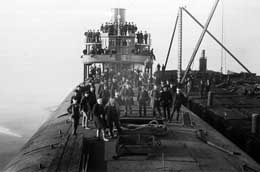On December 21, 1891, the so-called "whaleback" freighter Charles W. Wetmore arrives to great fanfare in the budding town of Everett on Port Gardner Bay in Snohomish County. The design of the steel-hulled vessel is a major maritime innovation, and her arrival marks the intense industrial boom overtaking the Everett Peninsula. Her captain and designer, Alexander McDougall, backed by East Coast money, will set up The Pacific Steel Barge Company with plans to employ 100 men.
A Unique, Whale-like Vessel
In 1872, McDougall, a Scottish-born Great Lakes captain, designed the new-type freighter hull made of steel to carry maximum loads while resisting water and wind. It had a flat bottom and a rounded deck for shedding water. The Port Gardner News reported:
"The bow rounded up like the rounded end of a cigar ... . Above water there was neither bulwark nor plank sheer, nor deck in the ordinary meaning of the word deck. The sides simply arched up over and met amidships. A section across the ship above the water line was simply the half of an ellipse. When she was loaded the top of the arch was perhaps four feet out of water. A wave in a gale would simply go rolling across her, scarce impeded by her pressure" (Port Gardner News, October 2, 1891).
Observers thought its appearance when fully laden was that of a whale, thus the name "whaleback." Detractors called it a pig and refused to use McDougall’s novel design. In response he started his own shipyard, the American Steel Barge Co., at West Superior, Wisconsin. His first vessel was the 101, thought to have been named after a comment of a friend who gave it 10-1 odds it wouldn’t work. McDougall went on to build 17 whaleback ships and 25 barges for the ore trade.
The Wetmore
The Charles W. Wetmore was the first whaleback to operate outside the Great Lakes. She had dimensions of 264 by 38 feet with a 16.4-foot draft and a tonnage of 3,000. She ran on a 700-horsepower steam engine and had four jury masts on which four trysails and a jib could be set for emergencies. A small cabin and a pilot house near the bow sat on the upper works. The pilot house had a turret with windows for observing conditions in any direction. She was named for one of McDougall's financial backers.
In June 1891, she sailed out of Duluth, down the Saint Lawrence rapids (she was too big for the locks) and headed for London. Her arrival there was a sensation. After returning to New York, she loaded up for the Pacific Northwest where investors made plans for a West Coast operation of the American Steel Company in Everett.
"The now celebrated whaleback steamship Charles W. Wetmore is the first whaleback that ever crossed the Atlantic," a reporter raved in the Port Gardner News. It "has successfully made a trip from Duluth, Minn., in the heart of the American continent, across the Atlantic Ocean to Liverpool and thence back to New York ... So successful has she proved from the beginning that the whaleback is now being loaded at New York for a voyage around Cape Horn to Puget Sound, in the Pacific state of Washington" (Port Gardner News, October 2, 1891).
For the next several weeks, newspapers closely followed her voyage:
"The whaleback Wetmore sailed from Willmington, Delaware, two weeks ago Tuesday. It will arrive at Everett sixty days from that date, if the conditions of the voyage are not unfavorable" (Port Gardner News, October 9, 1891).
"The whaleback Charles W. Wetmore has rounded the Horn and will be in Everett in 30 days" (Port Gardner News, November 13, 1891).
"Captain Alexander McDougall, inventor of the barge arrived in Everett, Wednesday. He is a reporter’s delight" (Port Gardner News, December 4, 1891).
On December 6, the Wetmore lost her rudder off the Oregon Coast. After repairs at Astoria, she continued on and arrived in Everett on December 21. She brought with her the machinery "for the factories of Everett" including iron for the construction of another whaleback and a supply of machinery for the nail factory and paper mill. Delighted citizens went down to board her.
The Wetmore was the pride of Everett, but the ship was short lived. On September 8, 1892, she grounded in a foggy Coos Bay and was lost. She had been carrying coal out of Tacoma for San Francisco.
City of Everett -- a Northwest Whaleback
Two years later the Everett company launched the first and only West Coast whaleback, the City of Everett. This ship was the first American steamship to go through the Suez Canal and to circumnavigate the world. She was in use into 1923.
The only reminder of the Wetmore is the street named for her at the top of the hill in downtown Everett. Her significance in maritime history has been largely forgotten.

